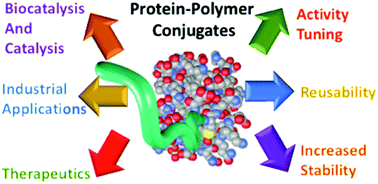Polymer conjugation of proteins as a synthetic post-translational modification to impact their stability and activity
Abstract
For more than 40 years, protein–polymer conjugates have been widely used for many applications, industrially and biomedically. These bioconjugates have been shown to modulate the activity and stability of various proteins while introducing reusability and new activities that can be used for drug delivery, and to improve pharmacokinetic ability and stimuli-responsiveness. Techniques such as RDRP, ROMP and “click” have routinely been utilized for the development of well-defined bioconjugate and polymeric materials. The synthesis of bioconjugate materials often takes advantage of the natural amino acids present within the protein and peptide structures for a host of coupling chemistries. Polymer modification may elicit increased or decreased activity, activity retention under harsh conditions, and prolonged activity in vivo and in vitro, and introduce stimuli responsiveness. Bioconjugation has resulted in modulated thermal stability, chemical stability, storage stability, half-life and reusability. In this review we aim to provide a brief account of the field, highlight a wide range of behaviors caused by polymer conjugation, and provide directions for future work.



 Please wait while we load your content...
Please wait while we load your content...
